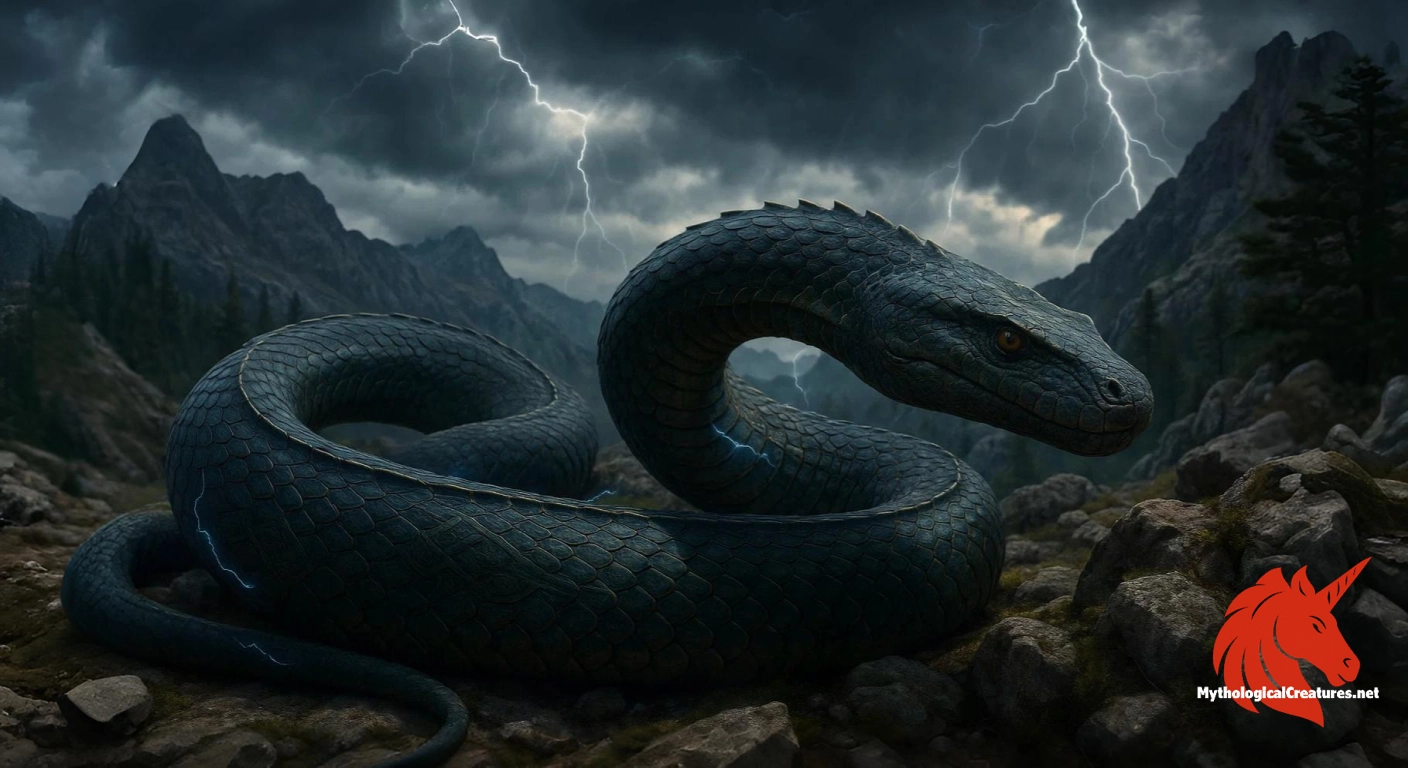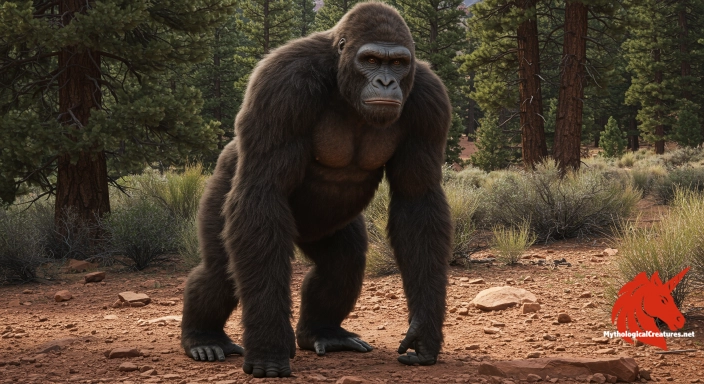Sugaar: Sugaar is a pre-Christian Basque deity, customarily depicted as a dragon or serpent.

Sugaar
Sugaar - Sugaar’s existence is central to weather phenomena in Basque myth, representing the primal force behind storms and the natural cycle of atmospheric power.
Origins & First Encounters
Sugaar emerges in the rich tapestry of Basque mythology as a formidable embodiment of the tempest and the wild, untamed forces of nature. His origins trace back to pre-Christian times, where he took form as a potent male deity frequently associated with storms and thunder. Often depicted as a dragon or serpent, his sinuous, dynamic character set him apart within the mythic pantheon. His role alongside his feminine consort, Mari, stands as a crucial symbol of natural balance, where their union stirs the elemental forces that generate life-giving and destructive storms. Despite his significant elemental power, Sugaar’s legends have survived in only a handful of records, contributing to his mysterious allure. Traditional Basque narratives hint at his vital presence in mountainous rituals, where his appearance heralds the coming of great tempests. The intermingling of myth and nature in his story underscores the reverence Basque peoples have for the unpredictable moods of the sky. His enduring presence in folklore continues to inspire interpretations that celebrate the intersection of nature’s beauty and its inherent danger.
Source Texts & Tale Variants
The primary narratives surrounding Sugaar are rooted in a blend of oral tradition and fragmentary literary sources, where his character is both elusive and enigmatic. Among the few surviving legends is a tale in which Sugaar seduces a Scottish princess in the village of Mundaka, leading to the birth of the mythical first Lord of Biscay. This intriguing myth appears to have been fashioned later to serve political ends, bolstering local claims of sovereignty against neighbouring influences. In contrast to other deities with extensive textual accounts, Sugaar is mentioned sparingly, leaving much of his lore to the power of local memory and ritual. His recurring role in the generation of storms—often in partnership with Mari—emphasises his elemental contribution to the mythic landscape. Various story variants, though limited in number, highlight his dual nature as both a bringer of chaos and a facilitator of renewal through the storm. The relative scarcity of consistent accounts often invites imaginative retellings, each adding layers of mysticism to his character. As a result, scholars and enthusiasts alike find Sugaar to be a compelling subject, ripe for reinterpretation and comparative study with other regional legends.
Form & Powers
Sugaar is vividly imagined as a towering, sinuous serpent or dragon whose appearance is as fluid and dynamic as the storms he commands. His body is often depicted with an elongated form, coiled and winding through the high mountain passes, symbolising the unpredictability of nature. Artists and storytellers alike have described his scales as glimmering in shades reminiscent of storm clouds, ranging from deep, foreboding greys to flashes of iridescent green. His eyes are reputed to burn with an inner light, capturing the electric tension of an impending tempest. In some accounts, hints of traditional draconic traits such as horns or a regal crest add to his majestic yet fearsome presence. His physical form is not static but is said to shift and undulate as if composed of the very forces of wind and water that he commands. This dynamic imagery serves to reinforce the idea that Sugaar is not merely a creature of myth but an embodiment of nature’s cyclical power. The detailed physical portrayals infused with both elegance and danger invite endless reinterpretations that mirror the ever-changing sky during a fierce storm.
Regional Faces
Regional interpretations of Sugaar reveal a remarkable flexibility in his portrayal across different parts of the Basque country. In some local traditions, he is revered as the consummate bringer of storms, with legends that depict him emerging from the depths of hidden mountain lairs. Conversely, other communities emphasise his serpentine nature, portraying him as a mysterious guardian that lurks on the fringes of familiar landscapes. The variant myth involving a Scottish princess in Mundaka illustrates how cross-regional influences can blend political lore with myth, thereby transforming him into an ancestral progenitor of local nobility. Each region adapts his image to resonate with local environmental features, be it the rugged coastlines or the soaring peaks of the Basque mountains. Some narratives accentuate his connection with the natural cycles of both destruction and regeneration, integrating him into seasonal rituals and communal celebrations. The interplay between his myth and local culture reinforces the idea that Sugaar is not a static figure, but rather one whose story adapts to regional needs and perspectives. Ultimately, these regional variations offer a fascinating glimpse into how local identities shape and are shaped by their mythological heritage.
Cultural Parallels
The myth of Sugaar invites comparison with a broader array of storm and dragon deities found throughout world mythology. Like the majestic Chinese dragon, whose powers are intertwined with natural elements, Sugaar embodies the dual aspects of creation and destruction that are universally associated with turbulent weather. His serpentine features and elemental prowess resonate with creatures such as the Norse World Serpent, Jörmungandr, albeit with distinct cultural inflections. Unlike the overtly anthropomorphic depictions seen in figures like Thor or Zeus, Sugaar’s more abstract, shifting form emphasises the uncontrollable forces of nature over humanised divine intervention. His recurring union with a female elemental deity mirrors dualistic themes observed in numerous myth systems, where the balance of male and female energies is central to cosmic order. These cross-cultural comparisons underscore the notion that storms and thunderstorms have been a common metaphor for both chaos and renewal across civilizations. Yet, Sugaar remains unique through his subtle literary presence and the way his myth has been interwoven with local political narratives. In this comparative light, his myth not only enriches Basque folklore but also contributes to an expansive, global dialogue about the symbolism of natural forces.
Legacy & Modern Evolution
Over the centuries, Sugaar’s myth has undergone significant transformation, evolving from sparse ancient records into a vibrant emblem of Basque cultural identity. As modern interest in regional mythologies has grown, artists, writers, and cultural scholars have reinterpreted his enigmatic figure in new and bold ways. Contemporary portrayals often blend traditional imagery with modern sensibilities, highlighting his role as a symbol of the untamed and unpredictable forces of nature. The initial fragments of his legend, once focused solely on storm generation, have expanded to include themes of transformation, duality, and even resistance against modern environmental challenges. His connection to political narratives—such as the tale of his union with a Scottish princess to legitimise local authority—adds a layer of cultural continuity that reroutes myth through the lens of heritage politics. This evolving narrative has sparked renewed academic interest, prompting comparative studies that link Sugaar with similar mythic figures worldwide. Modern reinterpretations have also found their way into festivals, public art, and literature, cementing his status as a dynamic icon of Basque identity. In essence, Sugaar remains a living myth, continually reimagined and revitalised to speak to both ancestral traditions and contemporary societal issues.
Interesting Fact
Sugaar not only personifies the elemental force of storms but also plays a role in regional identity, as seen in the myth linking him to the founding lineage of Biscay.
Quick Creature Info
Associations:
Our Mythic Legendary Rating:

Also Sometimes Known As:
Habitat:
Supernatural Powers:
Physical Attributes:
Abilities:
Behavior:
Lore:
Related Creatures, Tales or Lore
- JJörmungandr
- QQuetzalcoatl
- AApep
References
Discover Another Mythical Legend You May Not Have Heard Of?
Uncover the mysteries of ancient folklore and expand your knowledge of legendary beings from cultures around the world.
Dare to Meet the Mogollon Monster....
Curated by the Mythological Creatures Team (rev. May 2025)
